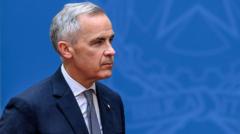With results anticipated by late Monday, the nation is witnessing a dramatic shift in political momentum, notably spurred by President Trump's trade war, impacting both the Liberal and Conservative Parties in this federal election.
Canada's Critical Election Day: Polls Close Amid Economic Turmoil

Canada's Critical Election Day: Polls Close Amid Economic Turmoil
As pivotal polls close across Canada, citizens face a crucial choice for their leadership in a period marked by international tension and trade disputes.
The first polls have closed across Canada as voters cast their ballots in an election poised to reshape the country's leadership during a turbulent juncture. Initial predictions suggested that the Conservative Party, led by Pierre Poilievre, had a solid lead over the Liberals under newly-appointed Prime Minister Mark Carney. However, shifting public sentiment in response to Trump's aggressive tariffs on Canadian goods has recently swung momentum back towards the Liberal Party, raising the stakes as votes are counted.
Results are due late Monday, with early indications showing a close contest between the two leading parties out of the 343 total parliamentary seats available. Although the New Democratic Party and the Green Party also contend, their influence is anticipated to remain limited.
Previously polling significantly ahead, the Conservatives' standing has faltered in light of Carney's rapid rise, following the resignation of the long-standing Prime Minister Trudeau amidst controversy. Carney has crafted a narrative focusing on economic stability and an anti-Trump stance, gaining traction among voters concerned about the potential repercussions of U.S. trade policies.
As Canadians navigate their electoral districts, it is the contrasting visions of Carney and Poilievre that dominate the discourse. Carney, a seasoned economist and former central banker, has promised stability and a strategic approach to international relations, whereas Poilievre's appeal relies on conservative values and economic deregulation, despite concerns he may represent a continuation of divisive American politics.
Polling has occurred across diverse time zones, with earlier closures in Atlantic Canada and scheduled finishing times extending to 10 PM Eastern for British Columbia. The paper ballot counting process is labor-intensive, relying solely on manual procedures without the assistance of technology, prompting gradual releases of results.
As Canadians await the outcomes, early returns suggest significant voter engagement, especially driven by economic concerns and the looming threat from the U.S. political landscape. Majority or minority government possibilities hinge on the outcomes within pivotal regions like Ontario and Quebec, with implications on the national response to global challenges looming large.
Overall, the election is unfolding as one that signifies not just a choice of leadership but also a response to unprecedented political pressures and economic decisions that have shaped the past and will dictate Canada's future.
Results are due late Monday, with early indications showing a close contest between the two leading parties out of the 343 total parliamentary seats available. Although the New Democratic Party and the Green Party also contend, their influence is anticipated to remain limited.
Previously polling significantly ahead, the Conservatives' standing has faltered in light of Carney's rapid rise, following the resignation of the long-standing Prime Minister Trudeau amidst controversy. Carney has crafted a narrative focusing on economic stability and an anti-Trump stance, gaining traction among voters concerned about the potential repercussions of U.S. trade policies.
As Canadians navigate their electoral districts, it is the contrasting visions of Carney and Poilievre that dominate the discourse. Carney, a seasoned economist and former central banker, has promised stability and a strategic approach to international relations, whereas Poilievre's appeal relies on conservative values and economic deregulation, despite concerns he may represent a continuation of divisive American politics.
Polling has occurred across diverse time zones, with earlier closures in Atlantic Canada and scheduled finishing times extending to 10 PM Eastern for British Columbia. The paper ballot counting process is labor-intensive, relying solely on manual procedures without the assistance of technology, prompting gradual releases of results.
As Canadians await the outcomes, early returns suggest significant voter engagement, especially driven by economic concerns and the looming threat from the U.S. political landscape. Majority or minority government possibilities hinge on the outcomes within pivotal regions like Ontario and Quebec, with implications on the national response to global challenges looming large.
Overall, the election is unfolding as one that signifies not just a choice of leadership but also a response to unprecedented political pressures and economic decisions that have shaped the past and will dictate Canada's future.






















